
- Phil
- August 14, 2025
How to Prepare for Moving Day with Seniors: A Complete Guide
Seniors often face unique challenges such as reduced mobility, medical requirements, and emotional stress tied to leaving a familiar home. Families need clear strategies that balance practical planning, safety measures, and emotional support to make the transition smoother.
A well-structured approach ensures that seniors are not overwhelmed by the process. From senior-friendly moving checklists to compassionate downsizing conversations, every detail matters in reducing anxiety and maintaining comfort.
This guide provides actionable steps on how to organize, plan, and support seniors throughout the moving journey.
Understanding the Needs of Seniors Before the Move
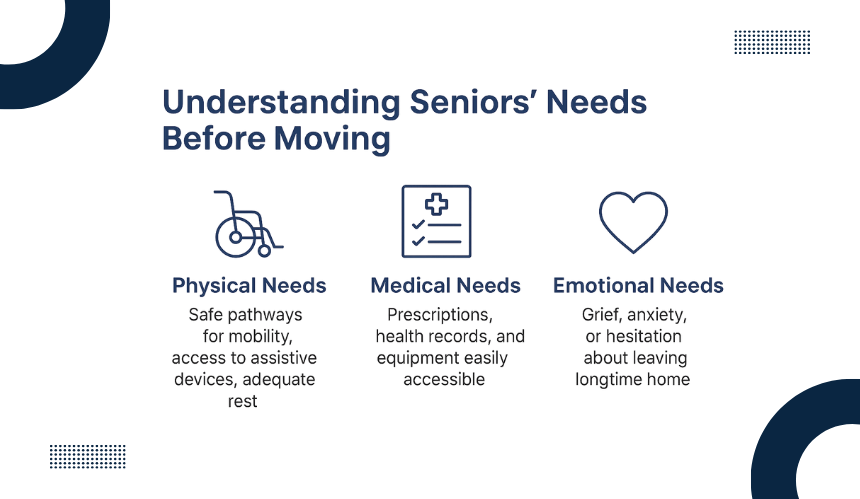
A successful relocation begins with identifying the unique needs of seniors. Unlike younger adults, older individuals often face challenges tied to health conditions, physical limitations, and emotional adjustment.
Physical needs may include safe pathways for mobility, access to assistive devices such as walkers or wheelchairs, and adequate opportunities for rest to avoid exhaustion. Medical considerations involve keeping prescriptions, health records, and medical equipment consistently accessible to prevent disruption in care.
Emotional needs are just as important. Leaving a longtime home can trigger feelings of grief, anxiety, or hesitation. Seniors may experience stress linked to uncertainty, loss of routine, or attachment to familiar surroundings.
Now we move on to the solutions that address these specific needs and make your move stress-free.
Creating a Senior-Friendly Moving Plan
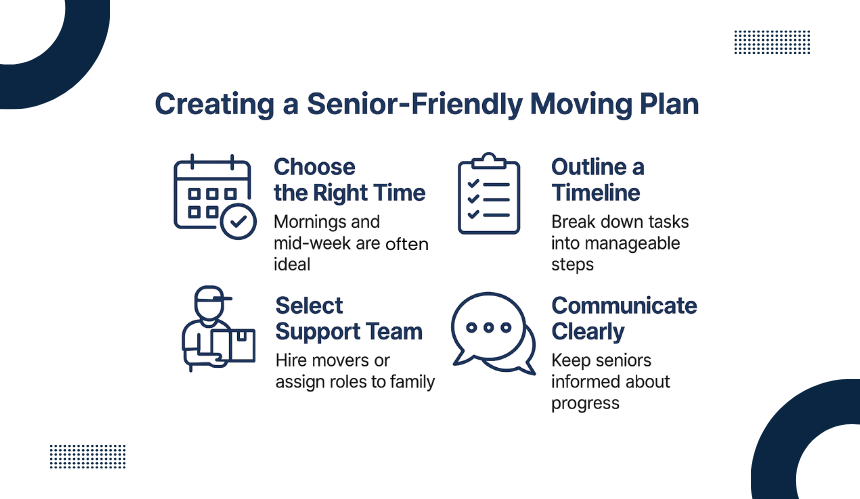
Every senior move requires careful preparation that accounts for timing, structure, support, and communication. A well-thought-out plan not only prevents logistical issues but also reduces stress for seniors and their families.
What is the best time for seniors to move?
The first step is choosing the right moving date and time. Early mornings or mid-week schedules often work best since they avoid fatigue, traffic delays, and extreme weather.
How do you build a moving timeline for seniors?
Once a date is set, families should outline a clear moving timeline. You should break down tasks into smaller steps, such as sorting, packing, and confirming transportation. This prevents seniors from feeling rushed or overwhelmed. A written moving day checklist helps caregivers and seniors track essential tasks and avoid last-minute confusion.
Should you hire movers who specialize in seniors?
Selecting the right support team is equally important. Professional movers who specialize in residential moves can provide tailored assistance. If hiring movers is not an option, family members should assign roles ahead of time so everyone knows their responsibilities.
Can communication reduce stress for seniors on moving day?
Planning also extends to communication. Keeping seniors informed about each stage reassures them that their needs are at the center of the process. The combination of an organized schedule, the right helpers, and consistent updates transforms moving day from a stressful event into a manageable transition.
Downsizing and Decluttering with Compassion
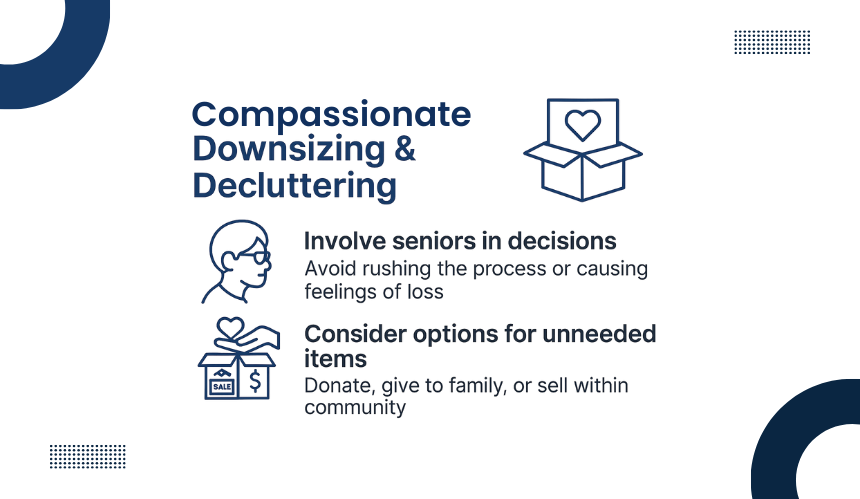
Before seniors move, downsizing is often necessary to make the transition manageable. Reducing belongings lightens the moving load and ensures that only meaningful and practical items are carried to the new home.
Why is downsizing important for seniors before a move?
A smaller living space or assisted living community may not accommodate years of accumulated possessions. Downsizing helps create a safer, clutter-free environment while making unpacking and settling in more efficient.
How do you declutter with compassion?
Decluttering should never feel rushed or forced. Seniors may hold deep emotional connections to household items, furniture, or keepsakes. Families should involve them in every decision to avoid feelings of loss or exclusion.
What should be done with unneeded items?
Unneeded belongings can be thoughtfully handled by donating to charities, gifting to family, or selling through community networks. This approach not only reduces clutter but also gives seniors comfort in knowing their possessions will continue to be valued by others.
Packing Strategies for Seniors
Packing for a senior move requires a focus on safety, organization, and accessibility. Unlike a standard household move, every box and item should be arranged with the seniors’ comfort and ease in mind.
How should packing be approached for a senior move?
Start with a clear plan that separates essentials from non-essentials. Priority items like medication, documents, clothing, and daily-use items should be set aside first to avoid misplacement. Daily necessities should be packed in a dedicated essentials box.
What is the safest way for seniors to handle heavy items?
To prevent injuries, heavy lifting should be minimized. Boxes must be packed lightly, keeping weight balanced and manageable. Family members or movers should handle bulkier items such as furniture or large appliances.
How can packing be made more organized for seniors?
Every box should be labeled in detail, not just with the room name but also with its contents. Large, legible labels help seniors and movers identify what is inside without unnecessary searching. Color-coded stickers or markers can further streamline unpacking.
Safety and Comfort on Moving Day
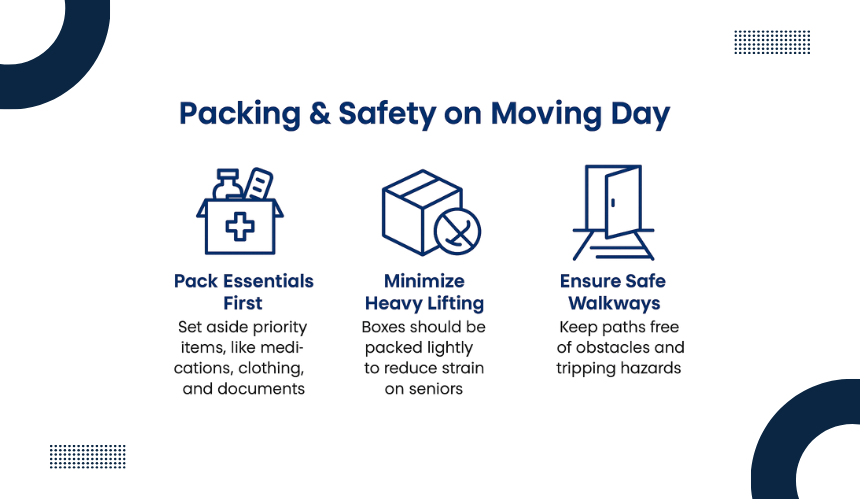
The day of the move can be exhausting for seniors. Keeping safety and comfort as the top priorities helps prevent stress and reduces the risk of accidents.
How can the home be made safer for seniors on moving day?
Walkways should remain clear of clutter, cords, or stacked boxes. Non-slip mats or secure rugs can prevent falls, and doorways should be free for easy access. Seniors should avoid carrying boxes to reduce the chance of injury.
What transportation arrangements are best for seniors?
A comfortable vehicle with easy entry and exit is essential. Seniors may prefer cars with higher seating or vans with supportive seating. Planning for extra time during travel avoids unnecessary rushing.
How do you maintain comfort during the moving process?
Frequent rest breaks, access to water, and light meals or snacks keep seniors comfortable. A quiet space away from the main moving activity allows them to relax and avoid feeling overwhelmed.
How should the new home be prepared for arrival?
The new living space should be set up in advance with basic necessities in place. Clear pathways, essential furniture, and immediate access to bathrooms create a safe and welcoming environment from the moment seniors walk in.
Settling In Smoothly After the Move
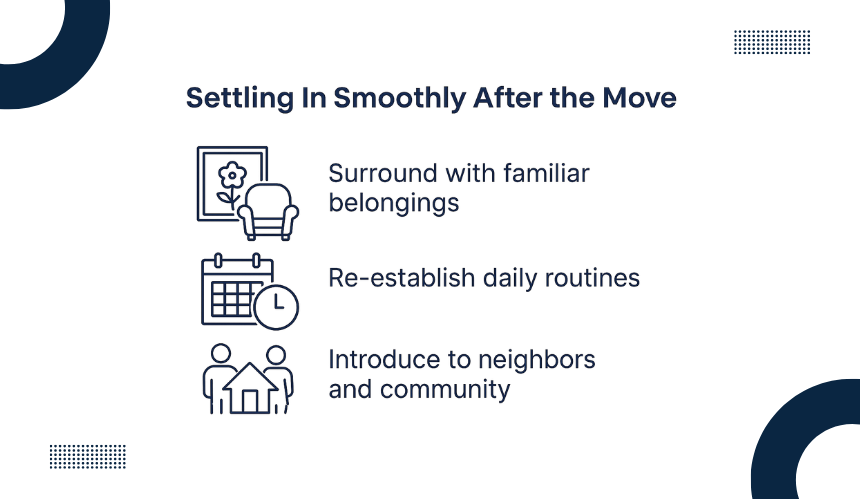
Settling into a new home is an important step in helping seniors feel secure and comfortable after relocation. Surrounding them with familiar belongings such as photographs, favorite furniture, or personal keepsakes makes the environment feel welcoming from the very first day.
Re-establishing daily routines like meal times, medication schedules, and leisure activities provides stability and reduces feelings of uncertainty. Introducing seniors to neighbors, nearby services, or local community groups further eases the adjustment and prevents isolation.
For a seamless and compassionate relocation, trust A Great Moving Crew with 15 years of experience to make every move safe, comfortable, and stress-free. Experience the difference of moving with care and expertise.
Frequently Asked Questions
What are the biggest mistakes families make when moving seniors?
The most common mistakes include underestimating the time required for downsizing, forgetting to pack an essentials bag, and not involving seniors in the planning process. Avoiding these errors makes the move smoother and less stressful.
How far in advance should a senior move be planned?
Planning ideally begins two to three months before the move. This allows enough time for sorting belongings, organizing paperwork, scheduling movers, and preparing the new home for comfort and safety.
What technology can help seniors adjust after relocating?
Simple tools like video calling apps, smart home devices, and medication reminder apps can help seniors stay connected, safe, and organized in their new home. These technologies provide reassurance for families while giving seniors greater independence and confidence in a new environment.
How can financial planning ease the stress of a senior move?
Budgeting for movers, downsizing services, and possible renovations reduces financial surprises. Families who prepare a clear budget upfront avoid last-minute stress and overspending.

